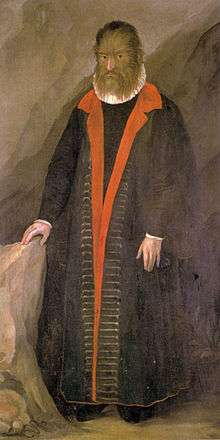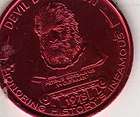Petrus Gonsalvus
Petrus Gonsalvus (Spanish: Pedro González, c. 1537 – c. 1618), referred to by Ulisse Aldrovandi as "the man of the woods",[1] was born in 1537 in Tenerife, Spain. His life has been well chronicled as he became famous during his lifetime because of his condition (hypertrichosis).
Biography
Gonsalvus first came to the court of Henry II, King of France in 1547, and was sent from there to the court of Margaret of Parma, regent of the Netherlands. He married while there. Later he was moved into the court of Alexander Farnese, Duke of Parma. Four of his seven children were also afflicted with hypertrichosis universalis and painted.[2] His family became an object of medical inquiry by Ulisse Aldrovandi among others. Despite living and acting as a nobleman, Gonsalvus and his hairy children were not considered fully human in the eyes of their contemporaries. Gonsalvus eventually settled in Italy with his wife. The last known record of him is from 1617, when he was listed among those who had attended his grandson's christening. It is believed that marriage between Petrus Gonsalvus and lady Catherine may have partially inspired the fairy tale Beauty and the Beast.[3][4]
He died in 1618 in Capodimonte near Rome.
Chamber of Art and Curiosities, Ambras Castle
The Chamber of Art and Curiosities, Ambras Castle collection in Innsbruck, Austria has a painting of Pedro González (Petrus Gonsalvus) as well as other people who display an extreme form of hirsutism, also called Ambras syndrome in 1933 in reference to its depiction at this collection.[5] In this space also is the famous portrait of Vlad Tepes.[5]
 Madelene Gonsalvas portrait 1580 Ambras collection
Madelene Gonsalvas portrait 1580 Ambras collection Henry Gonsalvas [Ambras Collection]
Henry Gonsalvas [Ambras Collection] Pedro González [Ambras Collection]
Pedro González [Ambras Collection] Portrait of Antonietta Gonsalvus by Lavinia Fontana, 1583.
Portrait of Antonietta Gonsalvus by Lavinia Fontana, 1583.-_Plate_II.jpg) Children of Petrus Gonsalvus by Joris Hoefnagel
Children of Petrus Gonsalvus by Joris Hoefnagel-_Plate_I.jpg) Petrus Gonsalvus and his wife Catherine by Joris Hoefnagel
Petrus Gonsalvus and his wife Catherine by Joris Hoefnagel
References

- Armand Marie Leroi, Mutants: on genetic variety and the human body (Penguin Books, Jan 25, 2005), also now as "the savage gentleman from Tenerife, Spain" 273.
- Chris Laoutaris, Shakespearean maternities: crises on conception in early modern England (Edinburgh University Press, 2008), 123.
- Gender Construction in La Belle et La Bete
- “La Bella y la Bestia”: Una historia real inspirada por un hombre de carne y hueso
- Erche B (August 2008). "Der schlimmste Boesewicht der Walachei" (PDF). Weltkunst (in German): 7. Archived from the original (PDF) on August 16, 2009. Retrieved June 30, 2009.
External links

- Petrus Gonsalvus